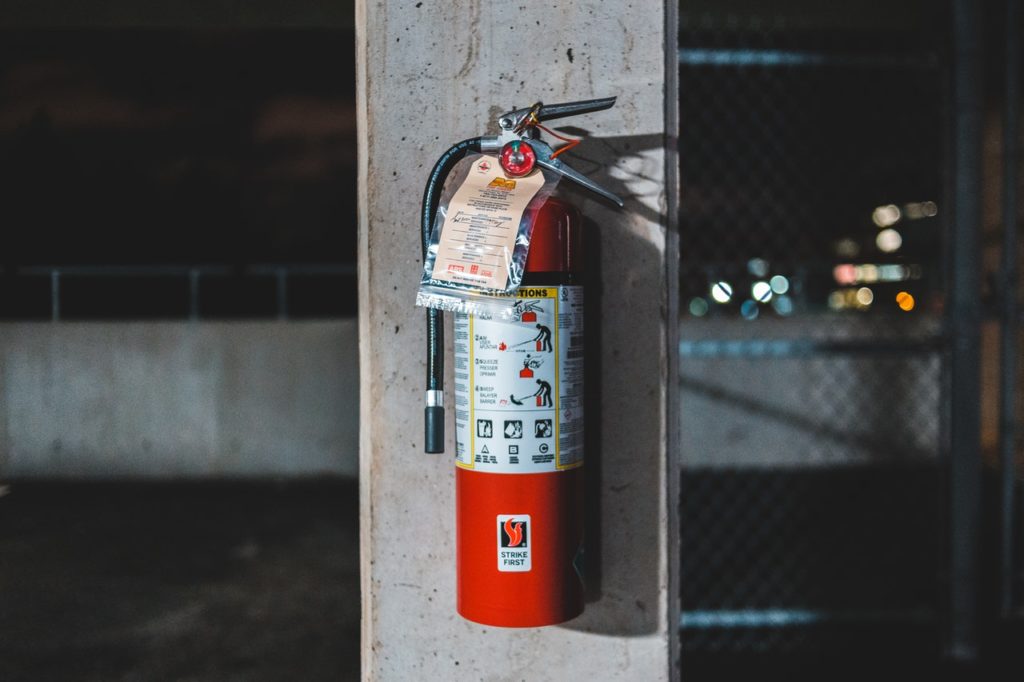
I learned this today. The first fire extinguisher was patented in 1723 by Ambrose Godfrey.
For thousands of years, the only way to fight fire was to bring water to it. If you lived too far from a water source, then your house was going to burn down. Friends, family, or anyone available would rush for water and carry it in buckets.
The first fire pump was invented in the third century BC by Ctesibius, a Greek citizen living in Alexandria. It was worked by volunteers. The first organized fire fighting service was started in Rome in about 80 BC.
It was started by Marcus Licinius Crassus, an extremely wealthy Roman politician. However, he wasn’t doing it out of the goodness of his own heart. His troop of 500 firefighters would find a burning building, and then stand around while someone working for Crassus offered to buy the building for far less than it was worth. Once it was sold, the firefighters put out the fire.
Firefighting improved over the centuries, but it became more important when more people started living in cities in the late 16th century and early 17th. Waiting for the fire service could sometimes take so long that the house could be lost. The idea of a fire extinguisher was born. The extinguisher invented by Ambrose Godfrey sat in the corner of a room or a factory. It was a cask of fire-extinguishing liquid with a chamber of gunpowder. It had fuses connected to it. When a fire started, it would ignite the fuse, the gunpowder would explode and spray the fire-extinguishing liquid all over the room.
The first portable extinguisher was invented in 1816. It was called the Extincteur and was invented by Captain George William Manby. It was a copper container that held 13 liters of a potassium carbonate solution. The solution was pressurized and it could be sprayed out of a hose. In design, it is very similar to modern extinguishers. When exposed to heat, potassium carbonate produces carbon dioxide, which replaces the oxygen that the fire needs and extinguishes it. It is still used in modern extinguishers for flammable gases and oils.
In 1866, a soda-acid extinguisher was invented by Francois Carlier in France. A soda-acid extinguisher utilizes the reaction between two substances to pressurize water and fire it out of the hose. It uses a water and sodium bicarbonate, with either tartaric acid or sulfuric acid. The acids are kept in a vial inside the cylinder. When you want to use the extinguisher, you break the vial, the acid falls into the solution, the reaction produces a huge amount of carbon dioxide, and the pressure forces the water out of the hose.
Aleksand Loran in Russia invented the foam fire extinguisher in 1905. He lived in an oil producing area of Russia and witnessed a fair few oil fires. Water doesn’t put out an oil fire because oil and water don’t mix. The water sinks under the oil, evaporates instantly, and creates masses of explosive steam, flinging burning oil everywhere. Loran used a compound of licorice root and sodium bicarbonate for the foam and a small container of 13% aluminium sulphate as the trigger. When the two solutions are mixed, carbon dioxide is produced which pressurizes the container. The licorice traps some of the carbon dioxide bubbles in the liquid, making it into a thick foam.
In 1910, a fire extinguisher using carbon tetrachloride was invented in America. The carbon tetrachloride solution vaporizes and interrupts the chemical chain reaction of the fire, extinguishing it. A fire grenade was invented using the same process. A glass ball of carbon tetrachloride would be thrown into the fire, extinguishing it when it smashed open. It turned out that carbon tetrachloride is highly toxic and when exposed to heat it becomes phosgene gas, which was one of the gases used in World War 1.
The carbon dioxide fire extinguisher was invented in 1924. It works by removing all of the oxygen that the fire needs to burn. And in 1928, a dry chemical extinguisher was invented. This used a compressed carbon dioxide cartridge to launch out a sodium bicarbonate solution treated with chemicals to make it moisture resistant.
These days, most fire extinguishers either use the carbon dioxide cartridge, or they are simply filled with a compressed gas.
Fire extinguishers have become lighter because of improvements in metal alloys, but they haven’t really changed that much in design for 50 years. However, the chemicals inside them have changed. There are now fire extinguishers for many different types of fire. Fires are generally divided into five or six different types, depending on where you live. America, for example, recognizes 5 different types of fire. A (for ash) are ordinary solid combustibles. B (for barrel) are flammable liquids and gas. C (for current) are electrical fires. D (for dynamite) are combustible metals. K (for kitchen) are oils and fats. I can’t help thinking that maybe they should have gone with “eating” to try and get ABCDE, rather than ABCDK.
So, the fire extinguisher was invented in 1723 and has gone through about 170 years of evolution to the extinguisher we have today. And this is what I learned today.
Photo by Erik Mclean from Pexels
Sources:
https://en.wikipedia.org/wiki/Fire_extinguisher
https://en.wikipedia.org/wiki/Potassium_carbonate
http://www.fireranger.com/history-of-the-fire-extinguisher/
https://en.wikipedia.org/wiki/History_of_firefighting
https://en.wikipedia.org/wiki/Marcus_Licinius_Crassus
https://www.fireandsafetycentre.co.uk/blogs/news/fire-fighting-grenade-not-so-hot
https://www.mentalfloss.com/article/64498/why-you-shouldnt-use-water-extinguish-grease-fire
